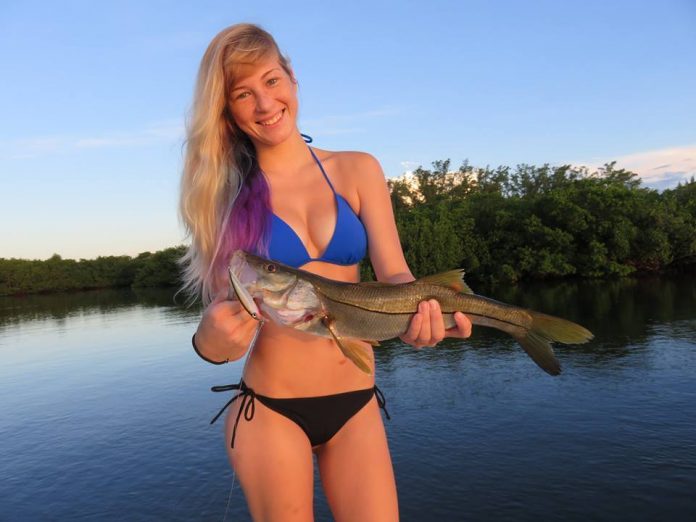Orlando Area and Mosquito Lagoon Fishing Forecast, November 2016

Although November’s notorious for greeting us with a blustery easterly fetch, fishing in the Mosquito Lagoon, Indian River Lagoon and the inlets of Ponce De Leon, Canaveral and Sebastian will remain outstanding until ocean water temperature drop below 70 degrees. Water levels are still elevated in the wake of Hurricane Mathew, but they will continue to fall and the water clarity has cleaned up. In a few weeks fishing conditions on the lagoons will be perfect. Currently a high pressure system has been blasting us with a strong easterly wind, but sooner or later Mother Nature will have to inhale and ocean conditions will bless us with some fishable days.
On the lagoons, falling water levels and cleaner conditions will facilitate increased sight fishing prospects for redfish, black drum and sea trout. Currently water levels in the lagoons remain elevated allowing excellent access to the backwaters, but on the flipside all of the sandy shoals are submerged, so if you are not familiar with the lagoons please exercise caution while under way.
In the inlets of Ponce De Leon, Port Canaveral and Sebastian, snook fishing will remain excellent during low light periods and at night as the remaining baitfish traveling south down the beach are forced in close to the jetties and other structure with the best action occurring during slack tidal periods, especially the end of high tide. During these periods hungry gamefish take advantage of slow currents and feed heavily. As the tide begins to fall, gamefish move into their ambush locations to finish off their frenzy. Breeder size redfish, snook, jack crevalle, bluefish, ladyfish, Spanish mackerel, sharks, and tarpon all share in the fury, so step up your tackle size and hold on.
One of my favored techniques when fishing the inlets in November is to cast net live mullet for bait, and drift them through the passes on a sliding sinker rig. Look for areas of feeding activity, birds diving and fish busting, and adjust the size of your weight based on current. The rig I use starts out with a Daiichi Bleeding Bait circle hook proportionate to your bait size to allow a natural swimming appearance. In simple terms, small bait small hook, large bait large hook. Next, I attach a 30-inch section of 30 to 40 pound test Gamma fluorocarbon leader to a 20-pound test braided mainline. If large tarpon are your target, step your leader size up to 60-pound test and your main line to 50 pound test. Before I tie on my hook, I slide my slip sinker on to the leader, and finish the rig off by using a small swivel located between the barrel sinker and the hook adjusted to keep the weight off of the hook. As I drift through the passes, I like to cast parallel to my drift with just enough weight to keep the bait in the feeding zone, and increase the barrel sinker size as the current picks up. Additionally, as we near the end of November and finger mullet diminish, switch to live pinfish on pigfish as bait. Most importantly, pass fishing in November can be dangerous, so as I drift through the inlet I keep the helm manned with my engine running, keeping a close eye on boat traffic and sea conditions, and always be prepared for evasive action if needed.
As the first significant cold front passes and surf temperatures reach the 68-degree mark, flounder slide into the inlets on their annual spawning migration out to sea. The exodus usually begins with the arrival of the smaller 1 to 3-poung gulf flounder (three spot), which are later joined by the doormat size 2 to 10-pound southern flounder. Many anglers prefer to anchor up and fish live finfish on the bottom, but I favor drifting the lagoon side of the passes bouncing a 1/4 ounce DOA CAL Jig 3″ CAL Shad tail on the bottom.. This vertical jigging technique allows me to cover more area and catch a wider assortment of species. Likewise, as lagoon temperatures cool, pompano are another likely target as they congregate on the lagoon side of the passes before moving out to their winter haunts along the beaches to feed on sand fleas (mole crabs) one of their favorite winter food.
In the near-shore ocean waters cobia and tripletail fishing can be very good this time of year depending on ocean temperatures (71 to 74 degrees is best) and winter weather conditions. To target them, head east out of Port Canaveral or Sebastian Inlet looking for rips, sargassum and flotsam pushed in by the easterly fetch. Once you have located the floating structure, work the rip with the sun to your back looking for fish suspended underneath, and catch then on spinning tackle or fly, and a live jumbo shrimp on a jig works best.
Last but not least, Hurricane Mathew runoff has pushed the water levels on the St Johns River up to flood stage in some areas and a strong easterly fetch in Jacksonville has held up river discharge, but the water levels have and will begin to drop fast. Currently, good reports of speckled perch (crappie) are coming in from the big lakes of Harney, Jessup and Monroe just in time for the 8th annual Central Florida Shad and Crappie Derby (https://www.facebook.com/cfshadderby). In addition to a good crappie bite, increased water levels equal increased currents, which sets the stage for an excellent channel catfish bite.
As always, if you have any questions or need more information, please contact me.
Good luck and good fishing,
Captain Tom Van Horn
Mosquito Coast Fishing Charters
407-416-1187
- January 2021:Tom Van Horn - December 31, 2020
- December, Tom Van Horn - December 1, 2020
- Tom Van Horn:November - October 30, 2020










